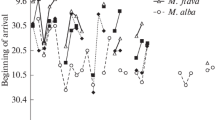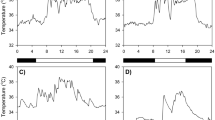Abstract
Three species of barnacles with boreo-aretic distribution were shown to require maintenance for several weeks below a critical temperature before the breeding condition could be attained. The temperatures critical for Balanus balanoides (L.) Balanus balanus (L.) and Balanus crenatus (Bruguière) were found to be between 10° and 12°C, 10° and 14°C, and at about 17°C, respectively. Although the strong influence of continuous light and the weak influence of continued feeding in delaying the onset of breeding in B. balanoides were confirmed, there remained some outstanding anomalies between the breeding behaviour of this species under laboratory conditions and between the tide marks. It was found impossible to initiate breeding by the application of conditioning procedures significantly in advance of the time of the normal Autumn breeding season in B. balanoides. Breeding appears to be inhibited, independently of external conditions, for a set period after the preceding brood cycle. Evidence points to a similar, largely endogenous, control of breeding in B. balanus which also breeds once annually, but not in B. crenatus which breeds continuously so long as food and temperature levels permit.
Similar content being viewed by others

Literature cited
Barnes, H.: Light, temperature and the breeding of Balanus balanoides. J. mar. biol. Ass. U. K. 43, 717–725 (1963a).
—: So called anecdysis in Balanus balanoides and the effect of breeding upon the calcareous shell of some common barnacles. Limnol. Oceanogr. 7, 462–473 (1963b).
— and M. Barnes: The general biology of Balanus balanus. (L) da Costa. Oikos 5, 63–76 (1954).
—: The effect of temperature on the oxygen uptake and rate of development of the egg masses of two common cirripedes, Balanus balanoides (L) and Pollicipes polymerus J. B. Sowerby. Kieler Meeresforsch. 15, 242–251 (1959).
— The effect of starvation and feeding on the time of production of egg masses in the boreoarctic cirripede Balanus balanoides (L). J. exp. mar. Biol. Ecol. 1, 1–6 (1967).
— and D. M. Finlayson: The seasonal changes in body weight, biochemical composition, and oxygen uptake of two common boreo-arctic cirripedes, Balanus balanoides and B. balanus. J. mar. biol. Ass. U. K. 43, 185–212 (1963).
— and D. J. Crisp: Evidence of self fertilisation in certain species of barnacles. J. mar. biol. Ass. U. K. 35, 631–639 (1956).
— and J. J. Gonor: Neurosecretory cells in the cirripede Pollicipes polymerus. J. mar. Res. 17, 81–102 (1958).
Crisp, D. J.: The breeding of Balanus porcatus (da Costa) in the Irish Sea. J. mar. biol. Ass. U. K. 33, 473–494 (1954).
—: A substance promoting hatching and liberation of young in cirripedes. Nature, Lond. 178, 263 (1956).
—: Effect of low temperature on the breeding of marine animals. Nature, Lond. 179, 1138–1139 (1957).
—: Factors influencing the time of breeding of Balanus balanoides. Oikos 10, 275–289 (1959a).
—: The rate of development of Balanus balanoides (L.) embryos in vitro. J. Anim. Ecol. 28, 119–132 (1959b).
—: Racial differences between North American and European forms of Balanus balanoides. J. mar. biol. Ass. U. K. 44, 34–45 (1964).
— and D. J. Clegg: The induction of the breeding condition in Balanus balanoides. Oikos 11, 265–275 (1960).
— and P. A. Davies: Observations in vivo on the breeding of Elminius modestus grown on glass slides. J. mar. biol. Ass. U. K. 34, 357–380 (1955).
— and B. Patel: The moulting cycle of Balanus balanoides (L). Biol. Bull. mar. biol. Lab., Woods Hole 118, 31–47 (1960).
— and D. A. Ritz: Changes in temperature tolerance of Balanus balanoides during its life cycle. Helgoländer wiss. Meeresunters. 15, 98–115 (1967).
— and A. J. Southward: The distribution of intertidal organisms along the coasts of the English channel. J. mar. biol. Ass. U. K. 37, 157–208 (1958).
— and C. P. Spencer: The control of the hatching process in barnacles. Proc. R. Soc. B 148, 275–299 (1958).
Fischer-Piette, E. and M. Prenant: Distribution des cirripedes intercotidaux d'Espagne septentrionale. Bull. Cent. Etud. Rech. scient., Biarritz 1, 7–19 (1956).
Gee, J. M. and G. B. Williams: Self-and cross-fertilisation in Spirorbis borealis and S. pagenstecheri. J. mar. biol. Ass. U. K. 48, 275–285 (1965).
Hutchins, L. W.: The bases for temperature zonation on geographical distribution. Ecol. Monogr. 17, 325–335 (1947).
Loosanoff, V. L. and H. C. Davis: Conditioning Venus mercenaria for spawning in winter and breeding its larvae in the laboratory. Biol. Bull. mar. biol. Lab., Woods Hole 98, 60–65 (1950).
McGregor, D. B.: The neurosecretory cells of barnacles. J. exp. mar. Biol. Ecol. 1, 154–167 (1967).
Patel, B. and D. J. Crisp: The influence of temperature on the breeding and moulting activities of some warm-water species of operculate barnacles. J. mar. biol. Ass. U. K. 39, 667–680 (1960a).
—: Rates of development of the embryos of several species of barnacles. Physiol. Zoöl. 33, 104–119 (1960b).
Pilsbry, H. A.: The sessile barnacles (Cirripedia) contained in the collection of the U. S. National Museum; including a monograph of the American species. Bull. U. S. natn. Mus. 93, 162 (1916).
Qasim, S. Z.: Time and duration of the spawning season in some marine teleosts in relation to their distribution. J. Cons. perm. int. Explor. Mer 21, 144–155 (1956).
Tighe Ford, D. J.: Possible mechanisms for the endocrine control of breeding in a cirripede. Nature, Lond. 216, 920–921 (1967).
Walley, L. J.: Histological and histochemical studies in cirripedes with special reference to secretory tissues. Unpublished thesis, University of Wales (1965a).
—: The development and function of the oviducal gland in Balanus balanoides. J. mar. biol. Ass. U. K. 45, 115–128 (1965b).
—: The cirral glands: a new type of epidermal gland in cirripedes. Crustaceana 12, 151–158 (1966).
Wells, H. W., M. J. Wells and I. E. Gray: On the southern limits of Balanus balanoides in the western atlantic. Ecology 41, 578–580 (1960).
Author information
Authors and Affiliations
Additional information
Communicated by J. E. Smith, Plymouth
Rights and permissions
About this article
Cite this article
Crisp, D.J., Patel, B. Environmental control of the breeding of three boreo-arctic cirripedes. Marine Biol. 2, 283–295 (1969). https://doi.org/10.1007/BF00351151
Accepted:
Issue Date:
DOI: https://doi.org/10.1007/BF00351151



